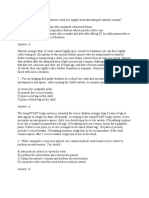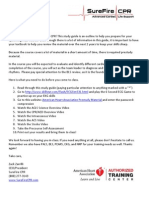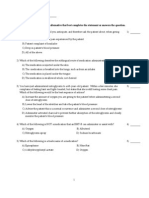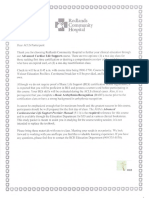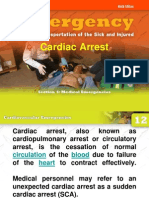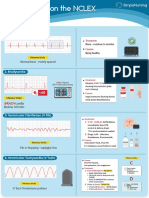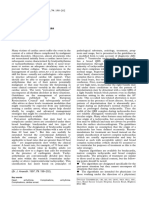Chapter 12 - Cardiovascular Emergencies
Chapter 12 - Cardiovascular Emergencies
Uploaded by
Junx TripoliCopyright:
Available Formats
Chapter 12 - Cardiovascular Emergencies
Chapter 12 - Cardiovascular Emergencies
Uploaded by
Junx TripoliOriginal Description:
Original Title
Copyright
Available Formats
Share this document
Did you find this document useful?
Is this content inappropriate?
Copyright:
Available Formats
Chapter 12 - Cardiovascular Emergencies
Chapter 12 - Cardiovascular Emergencies
Uploaded by
Junx TripoliCopyright:
Available Formats
Chapter 12
Cardiovascular Emergencies
12: Cardiovascular Emergencies
Objectives (1 of 6)
Describe the structure and function of the heart. Describe the care for patients experiencing chest pain. Identify the indications for using an AED. Define the role of the EMT-B in the emergency cardiac care system.
Emergency Care and Transportation of the Sick and Injured, 8th Edition AAOS
2
12: Cardiovascular Emergencies
Objectives (2 of 6)
Discuss the position of comfort for patients with cardiac compromise. Establish the relationship between airway management and cardiac compromise. Discuss fundamentals of early defibrillation.
Emergency Care and Transportation of the Sick and Injured, 8th Edition AAOS
3
12: Cardiovascular Emergencies
Objectives (3 of 6)
Explain importance of ACLS intervention. Discuss various types of AEDs.
State the need for assuring no pulse prior to attaching an AED.
Discuss circumstances resulting in inappropriate shocks.
Emergency Care and Transportation of the Sick and Injured, 8th Edition AAOS
4
12: Cardiovascular Emergencies
Objectives (4 of 6)
Discuss advantages and disadvantages of AEDs.
List the steps for using an AED. Differentiate between single- and multirescuer care with an AED.
Explain why pulses are not checked between shocks when using an AED.
Emergency Care and Transportation of the Sick and Injured, 8th Edition AAOS
5
12: Cardiovascular Emergencies
Objectives (5 of 6)
Discuss the importance of postresuscitation care.
Discuss the importance of completing the AED checklist.
Discuss the role AHA plays in the use of AEDs.
Emergency Care and Transportation of the Sick and Injured, 8th Edition AAOS
6
12: Cardiovascular Emergencies
Objectives (6 of 6)
List the indications for the use of nitroglycerin.
State contraindications and side effects for the use of nitroglycerin.
Define the functions of all controls on an AED.
Emergency Care and Transportation of the Sick and Injured, 8th Edition AAOS
7
12: Cardiovascular Emergencies
Blood Flow Through the Heart
Emergency Care and Transportation of the Sick and Injured, 8th Edition AAOS
12: Cardiovascular Emergencies
Electrical System of the Heart
Emergency Care and Transportation of the Sick and Injured, 8th Edition AAOS
12: Cardiovascular Emergencies
Coronary Arteries
Emergency Care and Transportation of the Sick and Injured, 8th Edition AAOS
10
12: Cardiovascular Emergencies
Cardiac Compromise
Chest pain results from ischemia Ischemic heart disease involves decreased blood flow to the heart. If blood flow is not restored, the tissue dies.
Emergency Care and Transportation of the Sick and Injured, 8th Edition AAOS
11
12: Cardiovascular Emergencies
Atherosclerosis
Materials build up inside blood vessels. This decreases or obstructs blood flow. Risk factors place a person at risk.
Emergency Care and Transportation of the Sick and Injured, 8th Edition AAOS
12
12: Cardiovascular Emergencies
Angina Pectoris
Pain in chest that occurs when the heart does not receive enough oxygen
Typically crushing or squeezing pain Rarely lasts longer than 15 minutes Can be difficult to differentiate from heart attack
Emergency Care and Transportation of the Sick and Injured, 8th Edition AAOS
13
12: Cardiovascular Emergencies
Acute Myocardial Infarction (AMI)
Pain signals death of cells. Opening the coronary artery within the first hour can prevent damage. Immediate transport is essential.
Emergency Care and Transportation of the Sick and Injured, 8th Edition AAOS
14
12: Cardiovascular Emergencies
Pain of AMI
May or may not be caused by exertion Does not resolve in a few minutes
Can last from 30 minutes to several hours
May not be relieved by rest or nitroglycerin
Emergency Care and Transportation of the Sick and Injured, 8th Edition AAOS
15
12: Cardiovascular Emergencies
Sudden Death
40% of AMI patients do not reach the hospital. Heart may be twitching.
Emergency Care and Transportation of the Sick and Injured, 8th Edition AAOS
16
12: Cardiovascular Emergencies
Arrhythmias
Bradycardia
Ventricular Tachycardia
Emergency Care and Transportation of the Sick and Injured, 8th Edition AAOS
17
12: Cardiovascular Emergencies
Cardiogenic Shock
Heart lacks power to force blood through the circulatory system.
Onset may be immediate or not apparent for 24 hours after AMI.
Emergency Care and Transportation of the Sick and Injured, 8th Edition AAOS
18
12: Cardiovascular Emergencies
Congestive Heart Failure
CHF occurs when ventricles are damaged. Heart tries to compensate. Increased heart rate Enlarged left ventricle
Fluid backs up into lungs or body as heart fails to pump.
Emergency Care and Transportation of the Sick and Injured, 8th Edition AAOS
19
12: Cardiovascular Emergencies
Signs and Symptoms of AMI
Sudden onset of weakness, nausea, and sweating
Chest pain or discomfort Pain in lower jaw, arms, or back Sudden fainting
Pulmonary edema
Sudden death
Emergency Care and Transportation of the Sick and Injured, 8th Edition AAOS
20
12: Cardiovascular Emergencies
Physical Findings of Cardiac Compromise (1 of 2)
Pulse rate increases. Blood pressure may be normal or falling. Respirations are usually normal. General appearance
Frightened
Nausea, vomiting, cold sweat
Emergency Care and Transportation of the Sick and Injured, 8th Edition AAOS
21
12: Cardiovascular Emergencies
Physical Findings of Cardiac Compromise (2 of 2)
Ashen gray skin Swollen neck veins with acute CHF Feeling of impending doom
Emergency Care and Transportation of the Sick and Injured, 8th Edition AAOS
22
12: Cardiovascular Emergencies
Approach to the Patient with Chest Pain (1 of 2)
Reassure the patient and perform initial assessment. Administer oxygen. Measure and record vital signs. Place the patient in a position of comfort.
Emergency Care and Transportation of the Sick and Injured, 8th Edition AAOS
23
12: Cardiovascular Emergencies
Approach to the Patient with Chest Pain (2 of 2)
Obtain focused history and physical exam. Ask about the chest pain using OPQRST. Assist with administration of prescribed nitroglycerin. Transport promptly. Report to medical control en route.
Emergency Care and Transportation of the Sick and Injured, 8th Edition AAOS
24
12: Cardiovascular Emergencies
Nitroglycerin
Forms Pill, spray, skin patch Effects Relaxes blood vessel walls Dilates coronary arteries Reduces workload of heart
Emergency Care and Transportation of the Sick and Injured, 8th Edition AAOS
25
12: Cardiovascular Emergencies
Nitroglycerin Contraindications
Systolic blood pressure of less than 100 mm Hg Head injury Patient age less than 15 years Maximum dose taken in past hour
Emergency Care and Transportation of the Sick and Injured, 8th Edition AAOS
26
12: Cardiovascular Emergencies
Assisting with Nitroglycerin (1 of 2)
Obtain order from medical direction. Take patients blood pressure. Check that you have right medication, patient, and delivery route. Check expiration date.
Find out last dose taken and effects.
Be prepared to lay the patient down.
Emergency Care and Transportation of the Sick and Injured, 8th Edition AAOS
27
12: Cardiovascular Emergencies
Assisting with Nitroglycerin (2 of 2)
Administer tablet or spray under tongue. Have patient keep mouth closed until tablet dissolves or is absorbed. Recheck blood pressure. Record each activity and time of application. Perform reassessment. May repeat dose in 3 to 5 minutes.
Emergency Care and Transportation of the Sick and Injured, 8th Edition AAOS
28
12: Cardiovascular Emergencies
Heart Operations
Coronary artery bypass graft (CABG) Angioplasty Cardiac pacemaker
Emergency Care and Transportation of the Sick and Injured, 8th Edition AAOS
29
12: Cardiovascular Emergencies
Automatic Implantable Cardiac Defibrillators (1 of 2)
Maintains a regular heart rhythm and rate Do not place AED patches over pacemaker.
Emergency Care and Transportation of the Sick and Injured, 8th Edition AAOS
30
12: Cardiovascular Emergencies
Automatic Implantable Cardiac Defibrillators (2 of 2)
Monitor heart rhythm and deliver shocks as needed. Low electricity will not affect rescuers.
Emergency Care and Transportation of the Sick and Injured, 8th Edition AAOS
31
12: Cardiovascular Emergencies
Automated External Defibrillation (AED)
AEDs come in two forms: Automated Semiautomated A specialized computer recognizes heart rhythms that require defibrillation.
Emergency Care and Transportation of the Sick and Injured, 8th Edition AAOS
32
12: Cardiovascular Emergencies
AED Use Problems
Battery is dead. Patient is moving.
Patient is responsive and has a rapid pulse.
Emergency Care and Transportation of the Sick and Injured, 8th Edition AAOS
33
12: Cardiovascular Emergencies
AED Advantages
ALS providers do not need to be on scene. Remote, adhesive defibrillator pads are used. Efficient transmission of electricity
Emergency Care and Transportation of the Sick and Injured, 8th Edition AAOS
34
12: Cardiovascular Emergencies
Non-Shockable Rhythms
Asystole Pulseless electrical activity
Emergency Care and Transportation of the Sick and Injured, 8th Edition AAOS
35
12: Cardiovascular Emergencies
Rationale for Early Defibrillation
Early defibrillation is the third link in the chain of survival. A patient in ventricular fibrillation needs to be defibrillated within 2 minutes.
Emergency Care and Transportation of the Sick and Injured, 8th Edition AAOS
36
12: Cardiovascular Emergencies
Using an AED (1 of 3)
Assess responsiveness, pulse, and breathing. Deliver breaths and begin CPR. Turn on AED. Apply pads. Stop CPR.
Emergency Care and Transportation of the Sick and Injured, 8th Edition AAOS
37
12: Cardiovascular Emergencies
Using an AED (2 of 3)
Clear patient. Analyze rhythm. If no shock advised, continue CPR. If shock advised, deliver up to three shocks. Check pulse and breathing after shocks delivered.
Emergency Care and Transportation of the Sick and Injured, 8th Edition AAOS
38
12: Cardiovascular Emergencies
Using an AED (3 of 3)
If patient begins breathing, give oxygen, and transport. If patient is not breathing, ventilate and transport. If there is no pulse, continue CPR for 1 minute. Re-analyze. Deliver three more shocks if needed. Transport and call medical control.
Emergency Care and Transportation of the Sick and Injured, 8th Edition AAOS
39
12: Cardiovascular Emergencies
After AED Shocks
Check pulse. No pulse, no shock advised No pulse, shock advised If a patient is breathing independently: Administer oxygen. Check pulse. If a patient has a pulse but breathing is inadequate, assist ventilations.
Emergency Care and Transportation of the Sick and Injured, 8th Edition AAOS
40
12: Cardiovascular Emergencies
Transport Considerations
Keep AED attached. Check pulse frequently. Transport: When patient regains pulse After delivering six shocks After receiving three consecutive no shock advised messages Stop ambulance to use an AED.
Emergency Care and Transportation of the Sick and Injured, 8th Edition AAOS
41
12: Cardiovascular Emergencies
Cardiac Arrest During Transport
(1 of 2)
Check unconscious patients pulse every 30 seconds. If pulse is not present: Stop the vehicle. Perform CPR until AED is available. Analyze rhythm. Deliver shock(s). Continue resuscitation according to local protocol.
Emergency Care and Transportation of the Sick and Injured, 8th Edition AAOS
42
12: Cardiovascular Emergencies
Cardiac Arrest During Transport
(2 of 2)
If patient becomes unconscious during transport: Check pulse. Stop the vehicle. Perform CPR until AED is available. Analyze rhythm. Deliver up to three shocks. Continue resuscitation according to local protocol.
Emergency Care and Transportation of the Sick and Injured, 8th Edition AAOS
43
12: Cardiovascular Emergencies
Safety Considerations
Make sure the electricity injures no one. Do not defibrillate a patient lying in pooled water. Dry a soaking wet patients chest first. Do not defibrillate someone who is touching metal that others are also touching. Remove nitroglycerin patches.
Emergency Care and Transportation of the Sick and Injured, 8th Edition AAOS
44
12: Cardiovascular Emergencies
AED Maintenance
Read operators manual. Check AED and battery at beginning of each shift. Get a checklist from the manufacturer. Report any failures to the manufacturer and the FDA..
Emergency Care and Transportation of the Sick and Injured, 8th Edition AAOS
45
12: Cardiovascular Emergencies
Medical Direction
Should approve protocols Should review AED usage
Should review speed of defibrillation Should provide review of skills every 3 to 6 months
Emergency Care and Transportation of the Sick and Injured, 8th Edition AAOS
46
12: Cardiovascular Emergencies
Cardiovascular System Changes with Age
Decreased pumping of heart Electrical system changes Atherosclerosis Decreased peripheral circulation (diabetes) AMI without pain
Emergency Care and Transportation of the Sick and Injured, 8th Edition AAOS
47
You might also like
- ECG Interpretation Cheat SheetDocument1 pageECG Interpretation Cheat Sheethirsi20051883% (30)
- ACLS Pre Test AnswersDocument10 pagesACLS Pre Test AnswersAirene Sible100% (3)
- EKG Exam Study Guide PDFDocument31 pagesEKG Exam Study Guide PDFmeb100% (2)
- WeitzmanDocument5 pagesWeitzmandanielmoffatNo ratings yet
- ALS Manual PDFDocument74 pagesALS Manual PDFBlack Owell100% (1)
- Oral Station Scenario PDFDocument3 pagesOral Station Scenario PDFlotuss45No ratings yet
- Pepp Als PretestDocument4 pagesPepp Als PretestDave BoppNo ratings yet
- Paramedic Pediatric Scenario 2017Document3 pagesParamedic Pediatric Scenario 2017Chad Street100% (1)
- AirwayDocument25 pagesAirwayKURIMAONGNo ratings yet
- Advanced Prov Itls Study Guide 7th EditionDocument13 pagesAdvanced Prov Itls Study Guide 7th EditionDave Amarasinghe100% (2)
- 2010 Integrated Updated Circulation ACLS Acute Coronary Syndromes AlgorithmDocument1 page2010 Integrated Updated Circulation ACLS Acute Coronary Syndromes Algorithmms_lezahNo ratings yet
- Respiratory EmergencyDocument36 pagesRespiratory EmergencyNidhita rai100% (1)
- Consent For Hospital CareDocument1 pageConsent For Hospital CareJunx TripoliNo ratings yet
- Examination of Cardiovascular System: IAP UG Teaching Slides 2015-16Document76 pagesExamination of Cardiovascular System: IAP UG Teaching Slides 2015-16Abdullah Mohammad Ibne Haider100% (1)
- Prehospital Trauma Life Support: Text OverviewDocument92 pagesPrehospital Trauma Life Support: Text Overviewasdnofal1986No ratings yet
- AEMT - Operations Exam PracticeDocument25 pagesAEMT - Operations Exam PracticeEMS Director100% (1)
- Appendix ADocument7 pagesAppendix ANoavilNo ratings yet
- Critical Care Transport ParamedicDocument3 pagesCritical Care Transport Paramedicapi-121427596No ratings yet
- AEMT - Medical Exam PracticeDocument26 pagesAEMT - Medical Exam PracticeEMS DirectorNo ratings yet
- ACLS CE-Part I of III - ECG Strip Interpretation W Case Scenarios SupplementalDocument80 pagesACLS CE-Part I of III - ECG Strip Interpretation W Case Scenarios SupplementalMarc Imhotep Cray, M.D.100% (2)
- Airway Management EssentialsDocument11 pagesAirway Management EssentialsCarlos Emmanuel Ramirez SantosNo ratings yet
- 1008 1400 ACLS - StudyGuide Print PDFDocument54 pages1008 1400 ACLS - StudyGuide Print PDFWaqar HassanNo ratings yet
- CPR ACLS Study GuideDocument18 pagesCPR ACLS Study GuideJohn Phamacy100% (1)
- ITLS Case Based Learning Scenarios Version 1.0 2019Document104 pagesITLS Case Based Learning Scenarios Version 1.0 2019Neil ThomasNo ratings yet
- Pharmacology For Paramedics: Jeremy Maddux, NREMTP, I/CDocument215 pagesPharmacology For Paramedics: Jeremy Maddux, NREMTP, I/CSreejesh RkNo ratings yet
- Atls 1Document5 pagesAtls 1Mega MalyndaNo ratings yet
- EMS CatalogDocument25 pagesEMS Catalogrrockel100% (1)
- ACLS Training - Most Important Points To RememberDocument5 pagesACLS Training - Most Important Points To RememberEman ElzeftawyNo ratings yet
- Chapter 16 ITLS - 04-2020Document20 pagesChapter 16 ITLS - 04-2020Ahyar Moh100% (2)
- Advanced Airway Management: Leaugeay Webre, BS, CCEMT-P, Nremt-PDocument35 pagesAdvanced Airway Management: Leaugeay Webre, BS, CCEMT-P, Nremt-Pbasic100% (4)
- Advanced Life SupportDocument65 pagesAdvanced Life SupportPrasad Narangoda100% (1)
- AHA ACLS Written Test: Ready To Study? Start With FlashcardsDocument8 pagesAHA ACLS Written Test: Ready To Study? Start With FlashcardssallyNo ratings yet
- EMT Basic - Chest TraumaDocument56 pagesEMT Basic - Chest TraumaPaulhotvw67100% (6)
- ParamedicCoach 1234 MethodDocument17 pagesParamedicCoach 1234 Methodjason.a.warfordNo ratings yet
- EMT HESI Prep Flashcards - PT 2Document4 pagesEMT HESI Prep Flashcards - PT 2Emily CallerNo ratings yet
- Brady SkillsDocument87 pagesBrady SkillsSahrensNo ratings yet
- EMT Review - Baseline Vital Signs and SAMPLE HistoryDocument7 pagesEMT Review - Baseline Vital Signs and SAMPLE HistorymrspatmoreNo ratings yet
- Transcutaneous Cardiac PacingDocument8 pagesTranscutaneous Cardiac PacingistiNo ratings yet
- Medical EmergenciesDocument67 pagesMedical EmergenciesYea Huei Chan100% (2)
- TraumaBurn ClinicalGuidelines Final PDFDocument34 pagesTraumaBurn ClinicalGuidelines Final PDFJuan Antonio GarcíaNo ratings yet
- Soft Tissue Injuries and Burns For EMT-BasicDocument37 pagesSoft Tissue Injuries and Burns For EMT-BasicPaulhotvw67100% (7)
- Basic Life Support Study Guide: Critical Care Training CenterDocument12 pagesBasic Life Support Study Guide: Critical Care Training CenterTODNo ratings yet
- EMT Section 2 Patient AssessmentDocument5 pagesEMT Section 2 Patient AssessmentMiguel Cuevas DolotNo ratings yet
- Pediatric Respiratory Emergencies: Nancy A. Johnson, Rrt/NpsDocument67 pagesPediatric Respiratory Emergencies: Nancy A. Johnson, Rrt/NpsAli Obadi AlhalemyNo ratings yet
- Advanced Cardiac Life SupportDocument37 pagesAdvanced Cardiac Life SupportRoy Acosta Gumban100% (1)
- HO - Burns Environmental EmergenciesDocument7 pagesHO - Burns Environmental EmergenciesSteven Paul DaclesNo ratings yet
- Trauma and Its ComplicationsDocument80 pagesTrauma and Its Complicationsjoe BouGhazaliNo ratings yet
- ACLS Test Sinus BradycardiaDocument1 pageACLS Test Sinus BradycardiaFiya Sahrul0% (1)
- Advanced Airway Management 4th YearsDocument39 pagesAdvanced Airway Management 4th YearsAmmaarah Isaacs100% (1)
- BLS FinalDocument47 pagesBLS Finalshouvik chowdhury100% (1)
- ACLS Practical Case Scenarios (1 June 2011)Document15 pagesACLS Practical Case Scenarios (1 June 2011)nersNo ratings yet
- Foreign Body Aspiration.Document40 pagesForeign Body Aspiration.Maria DodonNo ratings yet
- ITLS ChecklistDocument6 pagesITLS ChecklistgwenmylesNo ratings yet
- ACLS Study GuideDocument30 pagesACLS Study GuidemmmmzNo ratings yet
- Assessment and Initial Management of The Trauma Patient: Courtesy of BTLS OntarioDocument42 pagesAssessment and Initial Management of The Trauma Patient: Courtesy of BTLS OntarioAlexandria100% (1)
- Brady ArrhythmiasDocument36 pagesBrady ArrhythmiasSajin AlexanderNo ratings yet
- EMS Prehospital Care ManualDocument315 pagesEMS Prehospital Care ManualRhonda Bush100% (1)
- ACLS Simulation ScenariosDocument14 pagesACLS Simulation ScenariosVanessa HermioneNo ratings yet
- A Simple Guide to Abdominal Aortic Aneurysm, Diagnosis, Treatment and Related ConditionsFrom EverandA Simple Guide to Abdominal Aortic Aneurysm, Diagnosis, Treatment and Related ConditionsNo ratings yet
- Cardiac Arrest1Document27 pagesCardiac Arrest1Muhammad HaekalNo ratings yet
- Peri-Arrest Arrhythmias: AuthorsDocument11 pagesPeri-Arrest Arrhythmias: AuthorsMohammadAbdurRahmanNo ratings yet
- Cardiac Catheterization-1-2Document17 pagesCardiac Catheterization-1-2rana.said2018No ratings yet
- Presentation SHARKSDocument1 pagePresentation SHARKSJunx TripoliNo ratings yet
- Oxygen Concentrator 7F-5 User's ManualDocument9 pagesOxygen Concentrator 7F-5 User's ManualJunx TripoliNo ratings yet
- "Domestic Workers Act" or "Batas Kasambahay"Document2 pages"Domestic Workers Act" or "Batas Kasambahay"Junx TripoliNo ratings yet
- MCI Evaluator Sheet Per SectorDocument17 pagesMCI Evaluator Sheet Per SectorJunx TripoliNo ratings yet
- Ruth MoralesDocument5 pagesRuth MoralesFranyelis GutiérrezNo ratings yet
- Approach To Patient With PALPITATIONSDocument6 pagesApproach To Patient With PALPITATIONSIllumi ZoldyckNo ratings yet
- Peguero-Lo Presti Criteria Modified byDocument7 pagesPeguero-Lo Presti Criteria Modified bySajal SouravNo ratings yet
- Bedside Approach To Electrocardiography JapyeeDocument188 pagesBedside Approach To Electrocardiography JapyeeRichard MelialaNo ratings yet
- T Wave / T TalasDocument14 pagesT Wave / T TalasLidianaBeka0% (1)
- Defibrillation - Basic 55 For DistributorDocument14 pagesDefibrillation - Basic 55 For DistributorchanlalNo ratings yet
- Normal Impulse Conduction: Sinoatrial NodeDocument80 pagesNormal Impulse Conduction: Sinoatrial Nodesiusiuwidyanto100% (2)
- COVID-19 - Vaccine - AstraZeneca - UK - Vaccine Analysis Print 24 Nov 2022Document132 pagesCOVID-19 - Vaccine - AstraZeneca - UK - Vaccine Analysis Print 24 Nov 2022Mary-Jane StevensNo ratings yet
- 9 ECG Strips On The NCLEXDocument1 page9 ECG Strips On The NCLEXSibel ErtuğrulNo ratings yet
- Congenital Heart DefectDocument12 pagesCongenital Heart Defectsangkularosmina837No ratings yet
- ACLS Study Guide JULY 2021 UPDATEDocument3 pagesACLS Study Guide JULY 2021 UPDATENina Morada100% (3)
- Myocardial Infarction (Stemi) - Tennessee: Statpearls PublishingDocument3 pagesMyocardial Infarction (Stemi) - Tennessee: Statpearls PublishingMery AlizaNo ratings yet
- Cardiomegaly, RadiologyDocument20 pagesCardiomegaly, RadiologyJia LingNo ratings yet
- StemiDocument11 pagesStemidoubleraNo ratings yet
- Medication: Expected Pharmacological Action Therapeutic UseDocument1 pageMedication: Expected Pharmacological Action Therapeutic UseMike EveretteNo ratings yet
- B BLSDocument54 pagesB BLSJjeny LNo ratings yet
- Congenital Heart Diseases: DR - Ankita Patel MPT (Cardio-Pulmonary)Document41 pagesCongenital Heart Diseases: DR - Ankita Patel MPT (Cardio-Pulmonary)heena solankiNo ratings yet
- STEMI - Case ReportDocument42 pagesSTEMI - Case ReportWarren LieNo ratings yet
- Cardiac ArrestDocument7 pagesCardiac ArrestDiana MuañaNo ratings yet
- The ECG in Hypothermia - Osborn WavesDocument2 pagesThe ECG in Hypothermia - Osborn WavesVid MirosevicNo ratings yet
- PeriarestDocument5 pagesPeriarestMustafa ŠabićNo ratings yet
- Block 1 Board Review - Lecture NotesDocument127 pagesBlock 1 Board Review - Lecture NotesCece RereNo ratings yet
- Coronary Artery DiseaseDocument7 pagesCoronary Artery Diseasejmar767No ratings yet
- Poster 10 ALS-TACH 01 01 ENG V20100927Document1 pagePoster 10 ALS-TACH 01 01 ENG V20100927Andy XiaoNo ratings yet
- Algoritma Nyeri Dada - Dian WDocument4 pagesAlgoritma Nyeri Dada - Dian WfaberNo ratings yet















